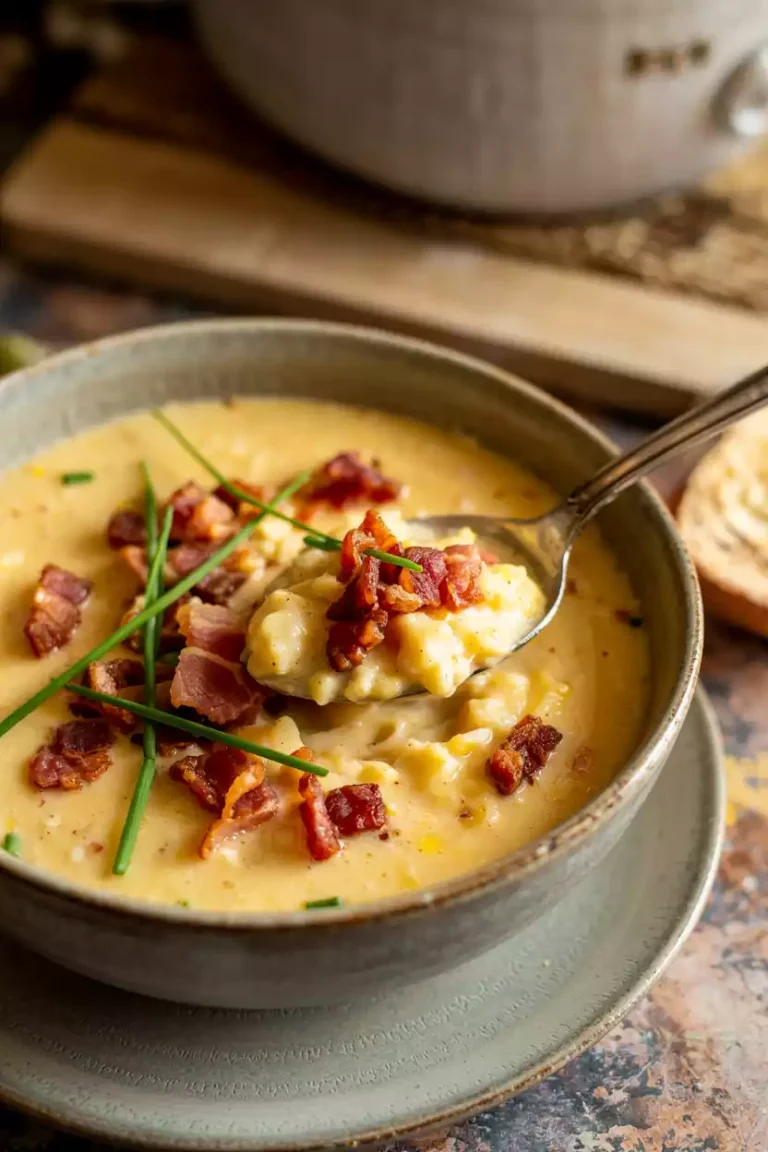Baked Potato Soup: Nothing says comfort quite like a steaming bowl of baked potato soup. Silky, creamy, and packed with rustic, hearty flavor, this comfort food soup has become a staple in diners, home kitchens, and high-end restaurants alike.
But what’s behind our collective love for this creamy potato soup? Where did it come from, and how did it evolve into such a versatile favorite? If you’re a home cook on the hunt for your next go-to soup, or simply a soup lover in search of culinary inspiration, this in-depth guide to potato soup will give you a new appreciation for the dish, how it fits into various cuisines, and the many delicious ways you can enjoy it.
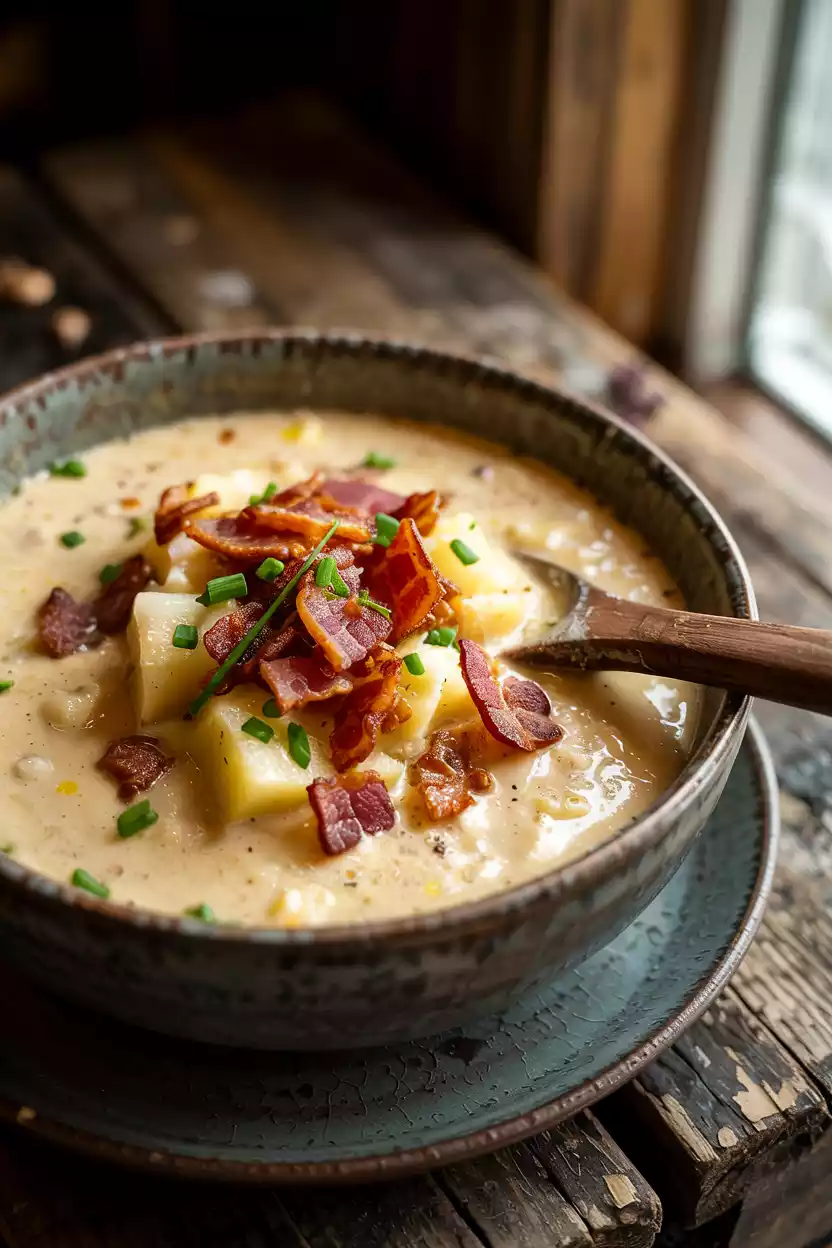
The Origin and History of Potato Soup
Baked potato soup feels like a classic American dish, but its roots stretch back to European traditions of using potatoes as the backbone of hearty soups and stews. Potatoes, first cultivated in South America, became a dietary staple following their adoption in European kitchens during the late 16th century.
The basic idea behind a creamy potato soup was simple: take inexpensive, filling potatoes and transform them into a dish that could feed a family. Early versions likely included nothing more than potatoes, water, and maybe a splash of milk or cream. As potatoes became embedded in the diets of European settlers in North America, this humble dish began its transformation. Over time, American cooks added richer dairy, bacon, cheese, herbs, and even sautéed onions to build more complex flavors.
By the 20th century, the concept of baked potato soup emerged, combining the beloved cooked potato with a creamy, luxurious base. Today, baked potato soup not only calls to mind the comfort of home-cooked meals but also represents the ongoing tradition of adapting classic dishes for new flavors and dietary preferences.
Nutritional Benefits of Potato Soup
While “comfort food soup” sometimes gets a bad rap for being heavy, baked potato soup offers a surprising number of nutritional benefits, especially when you’re mindful of the ingredients you use.
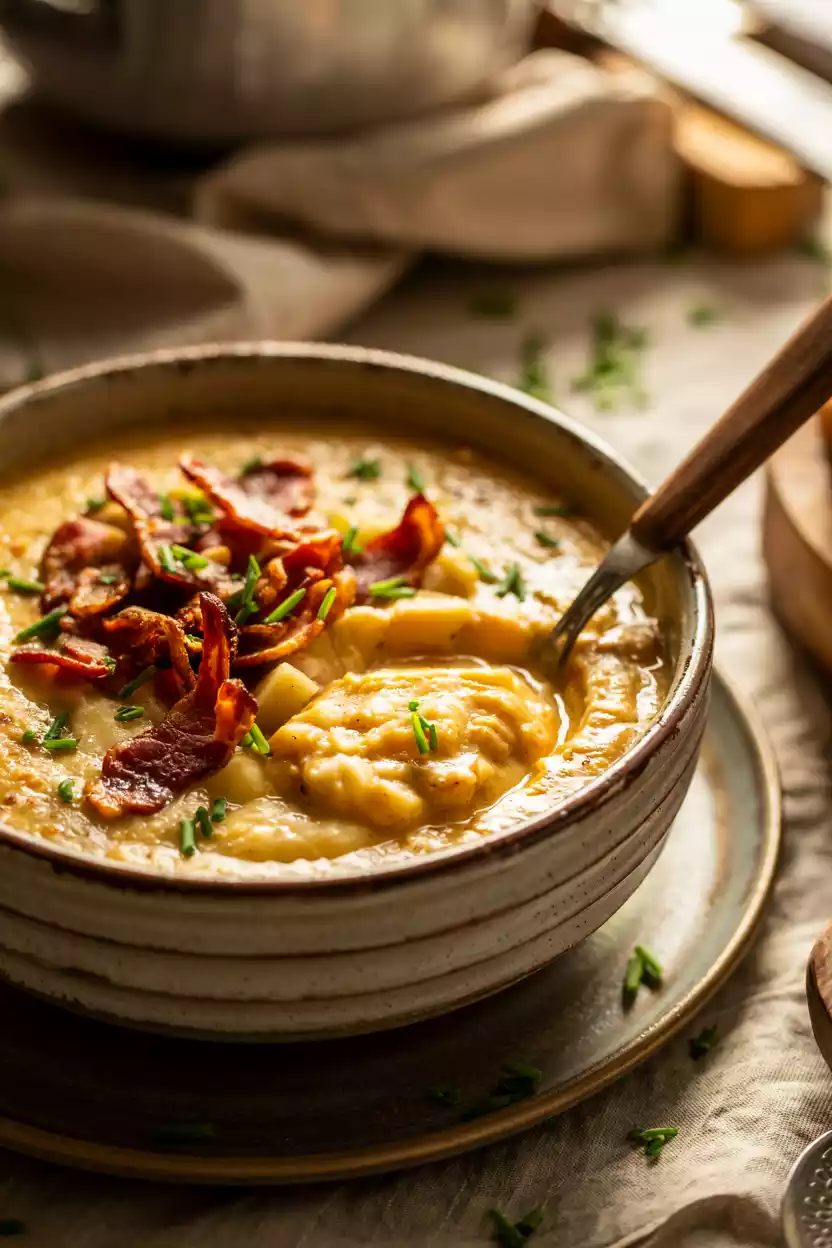
Key Nutritional Attributes:
- Potatoes are an excellent source of Vitamin C, potassium, and dietary fiber, promoting heart health and digestion.
- Milk or Cream adds necessary protein and calcium, forming the creamy backbone that gives this soup its signature rich texture.
- Vegetable Add-Ins (like onions, leeks, and carrots) can increase the fiber and micronutrient content while adding subtle layers of flavor.
- Toppings like cheddar cheese, chives, and bacon, while rich, can be portioned to manage calories and add bursts of flavor without overpowering the nutritional value of the soup.
For those watching calories or fats, you can easily lighten up baked potato soup by substituting low-fat dairy, swapping bacon for smoked turkey, or bulking up the vegetable content. On the other hand, when you’re after that classic creamy potato soup experience, a touch of butter and full-fat dairy is what makes it a true comfort food.
Baked Potato Soup: A Versatile Dish For Every Palette
One of the greatest strengths of baked potato soup is its versatility. Whether you prefer your soup rustic and chunky or ultra-smooth and creamy, this comfort food soup can be tailored to fit your taste, dietary needs, and pantry ingredients.
Customization Examples:
- Vegetarian Variations: Skip the bacon and load up on sautéed mushrooms, leeks, or spinach for a lighter but equally satisfying bowl.
- Vegan Adaptations: Use plant-based milk and vegan cheese substitutes; roasted cauliflower or white beans can add extra creaminess.
- Gluten-Free Adaptations: Baked potato soup is naturally gluten-free when you use cornstarch or potatoes alone to thicken.
Different regions and cooks have their own favorite spins, from Cajun spiced versions in the South to heavily garnished soups loaded with green onions in the West. Regardless of the version you choose, creamy potato soup adapts beautifully and always delivers on comfort.
Making the Perfect Baked Potato Soup
Success with potato soup is as much about technique as it is about ingredients. While the basic flavor profile remains the same, home cooks can elevate their version by paying attention to the details.
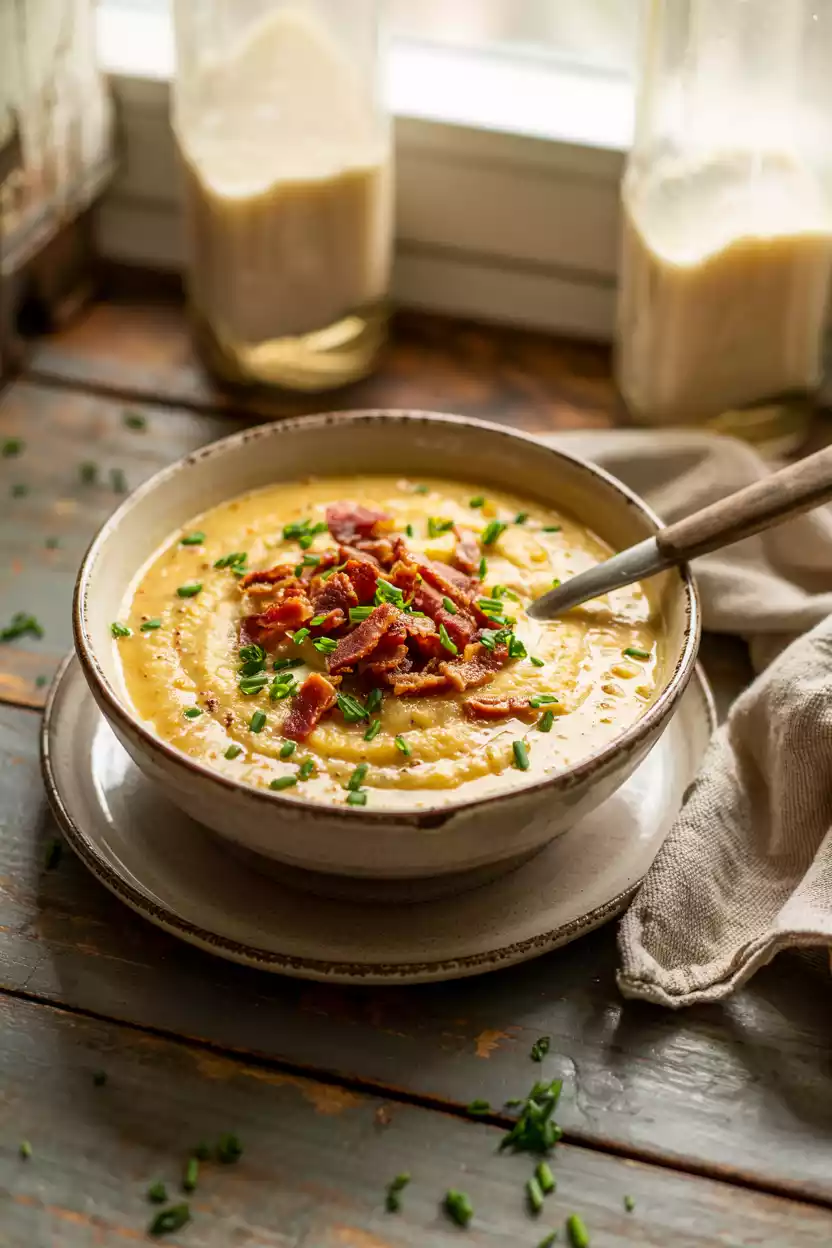
Essential Tips for Baked Potato Soup Mastery:
- Bake, Don’t Boil: Start with oven-roasted potatoes whenever possible. Baking concentrates the potato flavor and removes excess moisture, resulting in a thicker, more flavorful soup.
- Sauté the Aromatics: Cook onions, garlic, or leeks in butter before adding liquid. This step releases more flavor than simply boiling the ingredients.
- Creaminess Balance: Use a combination of milk and stock for a soup that’s rich yet not too heavy. Greek yogurt or sour cream at the end can add a tangy finish.
- Blend With Care: Decide if you want a chunky or smooth soup. For a rustic feel, mash some of the potatoes against the side of the pot instead of puréeing the whole batch.
- Finish With Flair: Top with crisp bacon, scallions, shredded cheese, or a drizzle of truffle oil for a restaurant-worthy touch.
By starting with quality ingredients and respecting the classic creamy potato soup techniques, you’ll find that each pot becomes more flavorful and satisfying than the last.
Variations of Baked Potato Soup That Soup Lovers Adore
Soup lovers and foodies know that potato soup is a blank canvas just waiting for layers of flavor and creative twists.
Popular Variations:
- Loaded Potato Soup: West meets East as classic loaded baked potatoes inspire a soup brimming with bacon, cheddar, sour cream, and chives.
- Southwest Potato Soup: Infuse your soup with cumin, smoked paprika, corn, and poblano peppers for a Tex-Mex vibe.
- Broccoli and Cheese Potato Soup: Add steamed broccoli and extra-sharp cheddar for a nutritional boost and earthy richness.
- Spicy Jalapeño Potato Soup: Stir in minced jalapeños and finish with smoked gouda for a soup with just the right kick.
Competitor blogs like Allrecipes and Food Network showcase dozens of reader-inspired takes, from dairy-free adjustments to holiday-ready gourmet versions with lobster or truffle. The possibilities are endless, and there’s no wrong way to personalize your creamy potato soup.
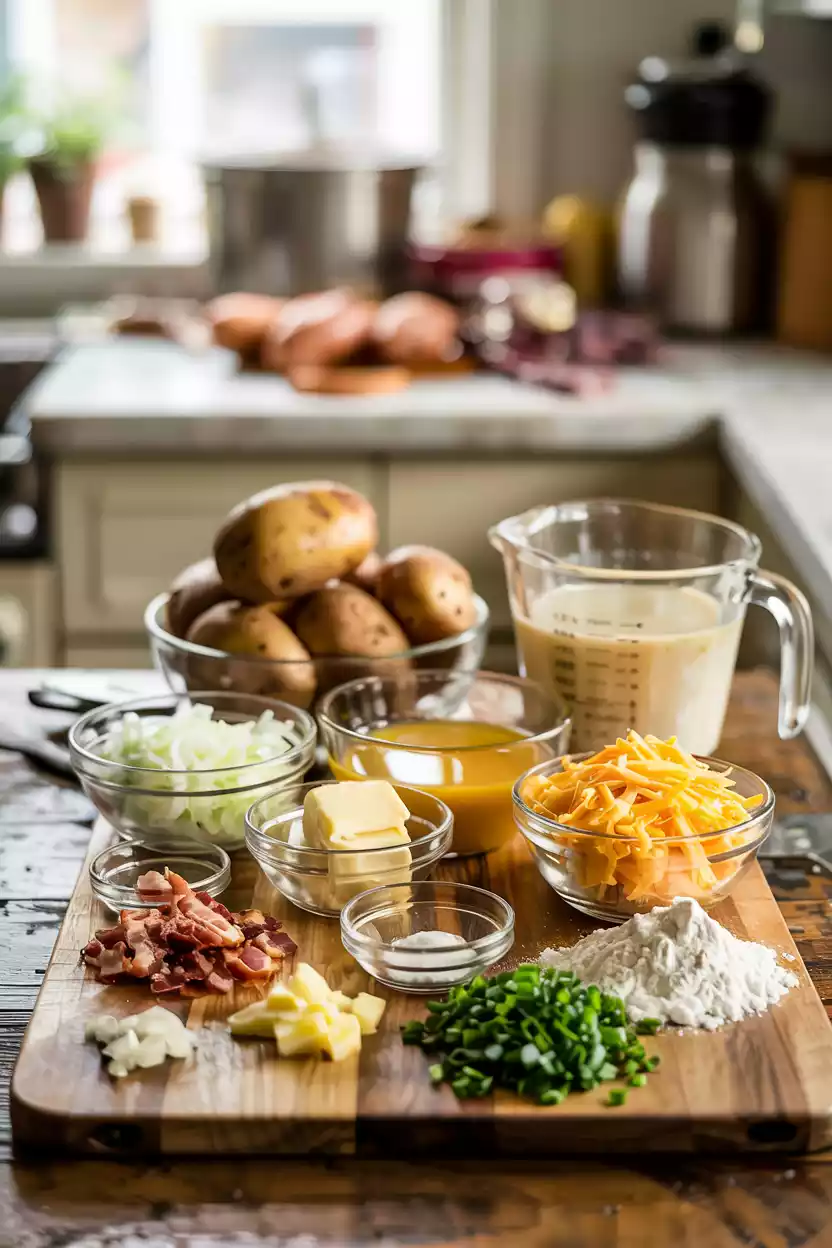
Serving Suggestions for Potato Soup
When serving baked potato soup, presentation and texture matter almost as much as taste. Here are some top serving ideas:
- Bread Bowls: Hollowed-out sourdough loaves turn comfort food soup into a showstopper.
- Small Cups: Serve in demitasse or espresso cups as an appetizer at dinner parties.
- Family Style: A big soup pot with a variety of toppings lets everyone customize their bowl.
- Garnishes: Don’t skip the classics. Chopped chives, sour cream, shredded cheese, crispy bacon bits, or fried shallots all add layers of flavor and enjoyable texture.
Pro tip from community-driven sites like Taste of Home and Cooking Classy: add your toppings right before serving to maintain freshness and crunch.
Pairing Baked Potato Soup with Other Foods
potato soup is hearty enough to stand on its own, but pairing it with the right foods can make your meal truly unforgettable.
Classic Pairings:
- Simple Salads: A crisp, tangy salad (think arugula with lemon vinaigrette) balances the richness.
- Grilled Veggies: Roasted asparagus, carrots, or Brussels sprouts bring out the earthy flavors of the soup.
- Savory Breads: From garlic knots to seeded rolls, bread and potato soup are a dream team.
- Light Proteins: Grilled chicken or salmon fillets pair well for a complete dinner without overpowering the soup’s subtle notes.
Whether served as a starter or main course, the right pairing makes any bowl of creamy baked potato soup shine all the brighter.
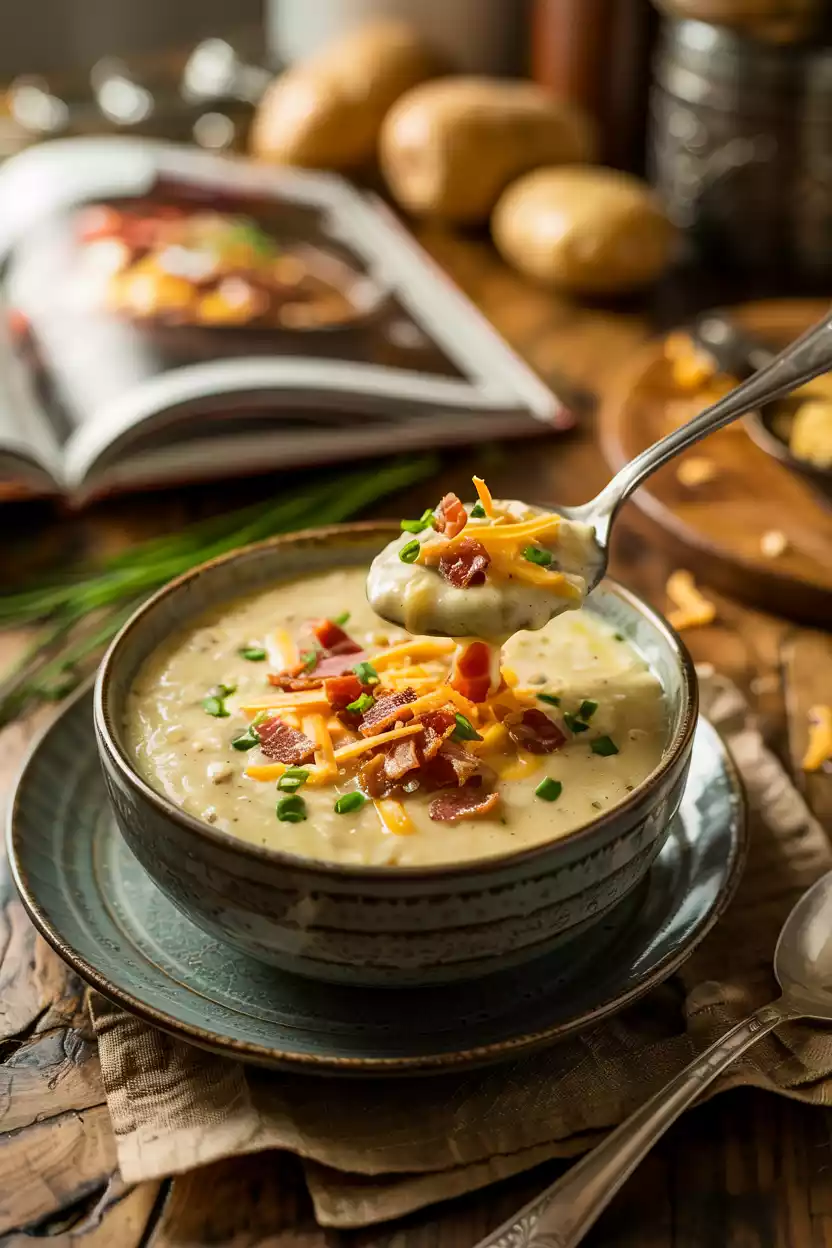
Baked Potato Soup for Special Occasions
Baked potato soup isn’t just for casual weeknights. It can be dressed up for celebrations, cozy gatherings, or even holiday meals. Here’s why it’s a go-to choice for special occasions:
- Crowd Pleaser: Easy to scale, delighting both kids and adults with creamy texture and familiar flavors.
- Make-Ahead Friendly: Can be prepared in advance and reheated without losing quality, freeing up host time on the day of your event.
- Customizable Bar: Set up a DIY topping station for parties, letting guests personalize their bowls.
From autumn harvest feasts to chilly winter evenings, baked potato soup is guaranteed to create warm memories and satisfy every guest.
Storing and Reheating Baked Potato Soup Like a Pro
Soup leftovers are a gift when stored properly. However, creamy potato soup does require some care to retain its wonderful texture.
Storage Tips:
- Cool Quickly: Store the soup in airtight containers in the refrigerator within two hours of cooking to prevent spoilage.
- Freeze Wisely: Many creamy soups can split after freezing, but using less dairy and more broth increases freezer-friendliness. Leave out toppings and add them fresh after reheating.
Reheating Guidance:
- Gentle Heat: Warm slowly on the stovetop over low–medium heat to prevent curdling. Stir regularly for even consistency.
- Microwave Tips: If using the microwave, heat in short bursts, stirring between each.
Proper storage and reheating ensure every bowl of leftover baked potato soup is just as satisfying as the first.
The Enduring Appeal of Baked Potato Soup
Few dishes capture the cozy essence of home like baked potato soup. This creamy potato soup straddles the line between luxurious and comforting, classic and endlessly adaptable. It blends straightforward pantry ingredients with culinary creativity, inviting everyone to find their own favorite twist.
For home cooks and comfort food lovers alike, baked potato soup is more than a meal; it’s an experience rich with history, flavor, and a feeling of togetherness. The next time you crave the warmth and satisfaction only a true comfort food soup can deliver, try exploring the possibilities of baked potato soup.
Whether you experiment with bold variations or stick to the traditional recipe, you’ll be rewarded with a hearty, satisfying dish that brings people together. Soup may be humble, but creamy potato soup proves it is anything but ordinary.
FAQs About Baked Potato Soup
Q1. Is baked potato soup gluten-free?
Most traditional baked potato soup recipes are gluten-free, especially if you thicken the soup with potatoes rather than flour. Always check individual ingredient labels to be sure.
Q2. Can I freeze baked potato soup?
You can freeze baked potato soup, but the texture may change due to the dairy content. For best results, freeze before adding cream or cheese and stir those in after reheating.
Q3. How long does baked potato soup last in the fridge?
Stored properly in an airtight container, baked potato soup will stay fresh in the refrigerator for up to four days.
Q4. How do I make a vegan or dairy-free creamy potato soup?
Substitute dairy milk with plant-based alternatives like almond or oat milk and use vegan cheese or nutritional yeast for creaminess and flavor.
Q5. What are some topping ideas for baked potato soup?
Classic toppings include shredded cheddar, sliced scallions, cooked bacon, sour cream, chives, and even crispy fried onions for crunch.
Q6. What can I use instead of bacon in baked potato soup?
For a smoky flavor without bacon, try smoked paprika, chipotle powder, or roasted mushrooms as a topping.
Q7. Why is my creamy potato soup too thick or thin?
If your soup is too thick, add a splash of broth or milk to loosen it up. If it’s too thin, simmer a bit longer uncovered or mash additional potatoes into the pot.
Q8. Can I use sweet potatoes instead of white potatoes?
Absolutely! Sweet potatoes can make a delicious and slightly sweeter version of baked potato soup. Adjust the seasonings to complement the new flavor profile.
No matter your palate or preferences, baked potato soup offers a deliciously comforting answer to both simple dinners and special celebrations. Happy soup making!
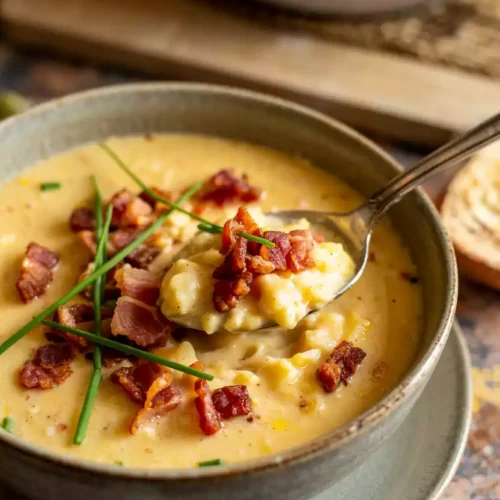
Baked Potato Soup Recipe
Ingredients
- 4 large russet potatoes equal to 2 lbs.
- ¾ teaspoon salt
- 6 slices thick cut bacon
- 1 large yellow onion
- 3 cloves garlic minced
- 2 Tablespoon butter
- ¼ cup flour
- 3 ½ cups Chicken broth
- 2 cups half and half
- ¾ cup sour cream
- ½ teaspoon pepper
- 2 cups shredded cheddar cheese
- 1/8 cup chives finely diced
Instructions
Prep Work
- Shred the cheese from a block, measure out the sour cream and half and half. Let them all sit out at room temperature.
Cooking Instructions
- Cut the bacon into 1-inch squares with kitchen shears. Cook in a large pot over low heat, rotating occasionally. They’ll overlap at first but will shrink down as they cook. Remove and set aside once crisp. Leave 2 Tablespoons of drippings in the pot.
- While the bacon cooks, peel the potatoes and cut them into 1-inch cubes. Add to a stock pot and cover the potatoes with 1 inch of water. Add the salt and boil gently for 20 minutes or until very fork tender. Drain, then gently mash. Set aside.
- Add the diced onion to the pot with the bacon drippings and cook until softened, about 5 minutes.
- Add garlic and butter and cook 1 more minute.
- Whisk in flour, use a silicone spatula to stir as the flour cooks for 1 full minute to remove the raw flour taste.
- Add the chicken broth. Use a silicone spatula to loosen any bacon remnants from the bottom of the pot, this will add flavor.
- Slowly add the half and half. Bring to a boil, then reduce to a simmer.
- Stir in the potatoes, then mix in the sour cream, and pepper.
- Remove from heat. If desired, blend with an immersion blender or transfer it to a blender in batches. (I prefer to do this for a creamier and smoother consistency.)
- Gradually sprinkle with shredded cheese and stir until combined. Make sure the base of the soup isn’t too hot or the cheese won’t melt creamy and smooth. The soup will continue to thicken as it sits.
- Garnish with chives and bacon, serve!
Notes
- Cheese: Cracker Barrel Sharp Yellow Cheese is my brand of choice as it has great flavor and melts smoothly. Aged/crystalized cheese won't melt well, aim for a soft consistency!
- Avoid using bagged shredded cheese, as it contains cellulose which prevents the cheese from melting smoothly.
- Milk may be used instead of half and half, just note that the broth won’t be quite as thick. Microwave the milk for 45 seconds prior to adding it to avoid curdling.
- This recipe is in The Cozy Cookbook on page 36!
Pinterest: Baked Potato Soup: Creamy Unique Soup You Need To Try

